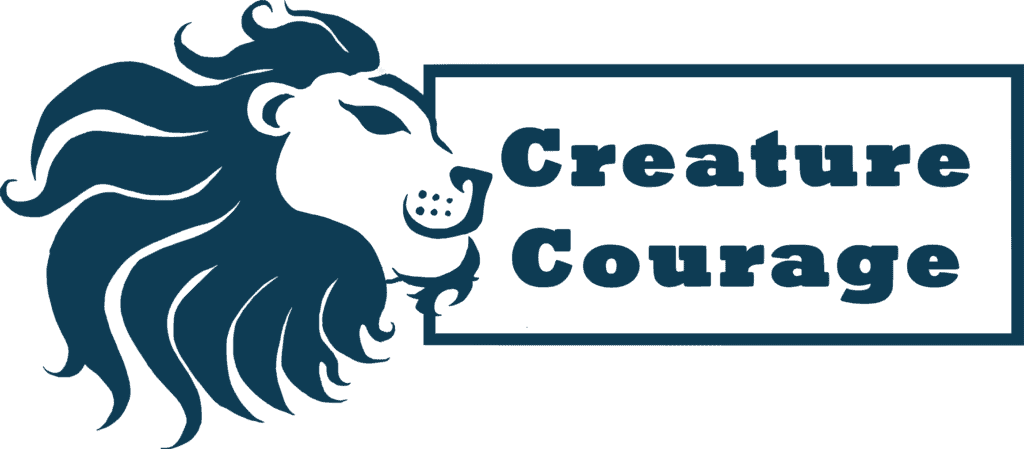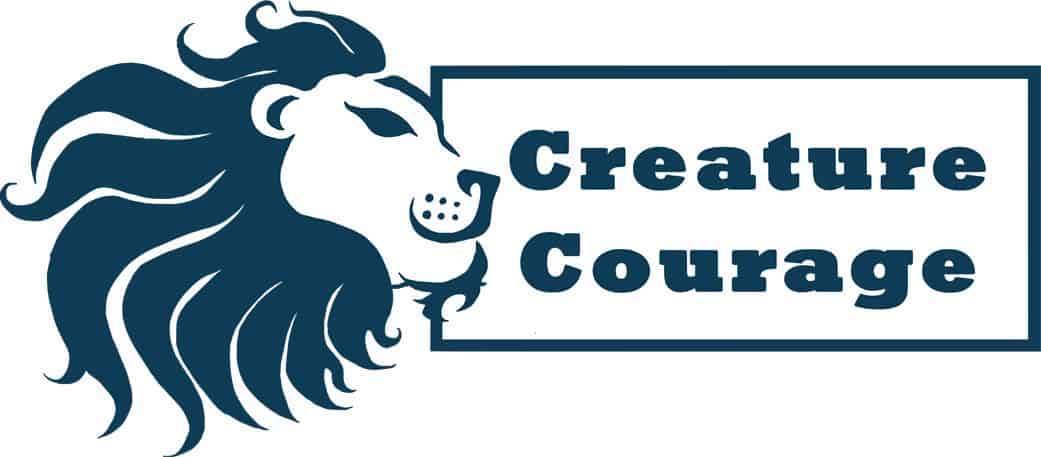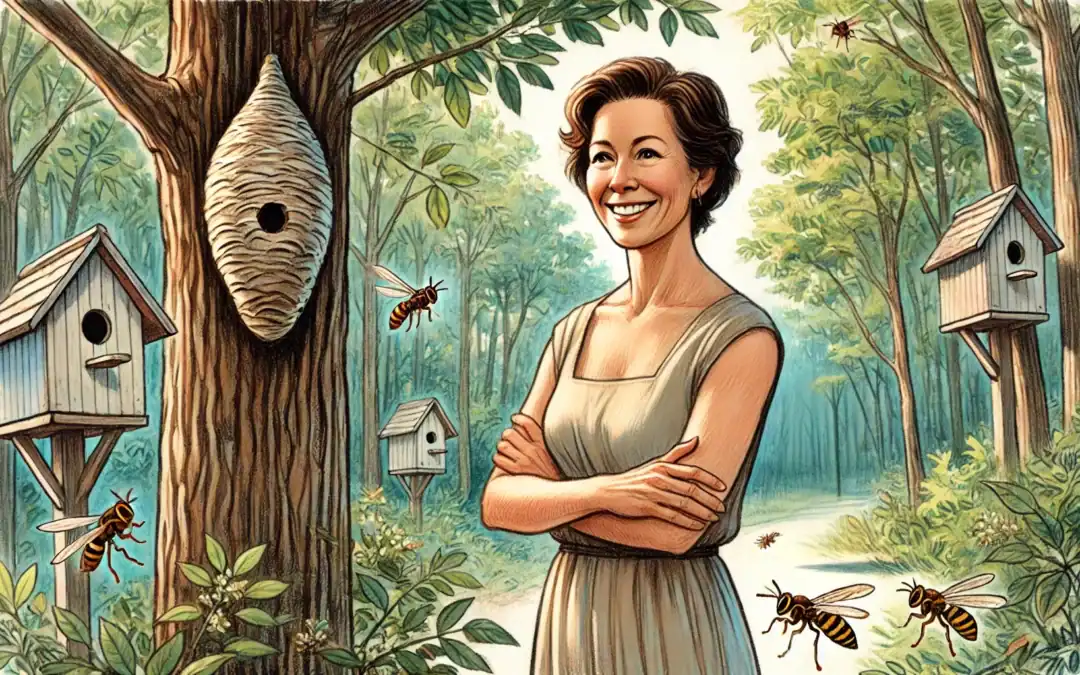Buzzing with Creativity: Introducing the Paper Wasp
Paper wasps, named for the papery nests they craft, truly are nature’s architects. These fascinating insects build intricate structures from chewed-up bark and wood fibre – homes that can support thousands. Despite their delicate forms and elegant nests, paper wasps may be some of the UK’s most misunderstood insects. Like any wasp, their appearance often sparks fear, but behind it lies a story of grace, intelligence, and ecological value. Paper wasps act as peaceful builders, attentive caretakers, and surprisingly helpful neighbours. When you give yourself the opportunity to look closer, fear often gives way to fascination – and we can begin to see why paper wasps deserve respect, not panic.
Find Your Fascination with Creature Courage
Paper Wasp Phobias
As one of the UK’s most common wasps, paper wasps often trigger fear – especially in those who’ve been stung before by another type of wasp. Some people develop intense anxiety that evolves into phobias. This Spheksophobia, or fear of wasps, can be triggered by what might be considered ‘small things’ – such as the sight of a paper wasp’s nest – but cause anxiety and panic, regardless. Symptoms go beyond the urge to just flee – they can be a combination of mental and physical symptoms such as a racing heartbeat, uncontrolled sweats, dizziness, extreme terror or even a sense of detachment from the world around you.
Why People Fear Paper Wasps
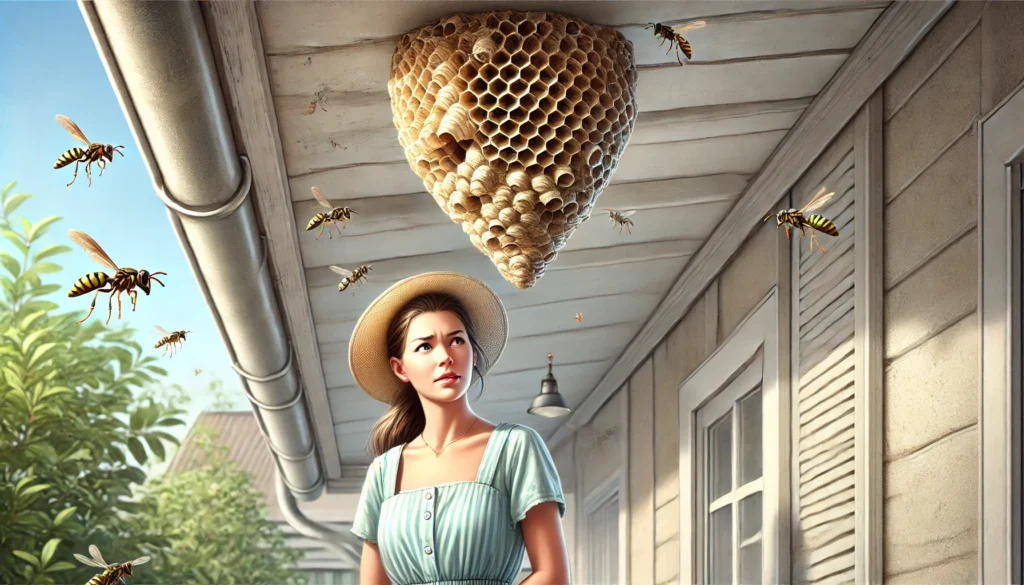
For many, the fear of paper wasps runs deep – and it’s not just about the sting. Most animal fears develop from the fear of being out of control and an intolerance to unpredictability. This fear often arises from a combination of personal experience, learned behaviours, and social influence:
Traumatic encounters
A painful sting – especially during childhood – can leave a lasting emotional mark. Even a single unexpected encounter with a wasp can condition the brain to associate these insects with danger. The body responds with fight-or-flight symptoms, including a racing heart and panic. Over time, this anxiety may intensify and generalise to all wasps, even when they pose no real threat.
Learned behaviour
Phobias are often passed on, unintentionally, by people we trust. Children who see parents or caregivers react with panic to wasps may internalise that response. Additionally, repeated exposure to this fear can solidify it, even if the child has never been stung themselves. In this way, fear becomes a habit rather than a reaction to actual danger.
Cultural messaging
In media and popular culture, wasps are frequently depicted as villains—aggressive, vindictive, and out to sting. Tabloid headlines, exaggerated warnings, and even cartoons often cast them as pests to be feared or destroyed. This constant negativity reinforces the idea that paper wasps are something to dread, rather than understand.
By recognising the roots of this fear, we can begin to question its validity and therefore open the door to healing and coexistence.
How Spheksophobia Is Learned
Spheksophobia – an intense, irrational fear of wasps – is not something people are born with. People learn through experience and social influence, often without conscious awareness. Understanding how this fear develops is the first step toward overcoming it.
Classical conditioning
This occurs when a neutral object (like a wasp) becomes associated with a negative event (like a sting). The brain links the two together, so that even the sight or sound of a wasp triggers fear. This response can be automatic and deeply ingrained, but the good news is that it can also be unlearned.
Observational learning
Humans are hard wired to mimic and learn from each other. If a child repeatedly sees a parent scream, flinch, or run from a wasp, they may come to believe the insect is dangerous – despite never having a negative experience themselves. Over time, this response can become just as strong as if they had been stung.
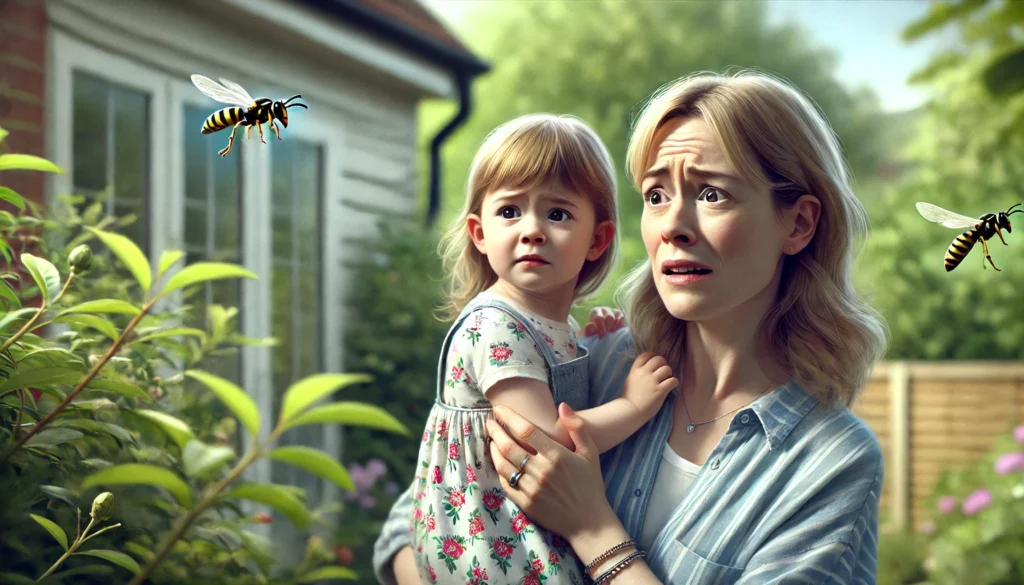
Cultural reinforcement
Phobias are often supported by society. News reports, horror stories, and even schoolyard tales can exaggerate the threat wasps pose. Often these narratives stick and thus shaping our expectations and emotional responses. Repeated messages like “wasps are aggressive” or “they’re out to get you” feed the phobia and make it harder to break.
But just as fear can be learned, it can also be replaced – with understanding, education, and supportive therapy.
How Common Is Wasp Phobia?
Around 10–15% of UK adults suffer from specific phobias such as spheksophobia .
Insect phobias are among the most common. Nearly 6% of US adults fear insects generally.
Awareness is growing, helping more individuals seek treatment.
Sadly even if people do not have a phobia of these creatures, many still hate and kill them. Therefore, lets learn a little more about these misunderstood and fascinating creatures to start to reframe our perspectives. Building compassion and fascination are powerful tools to get over the fear of wasps. Additionally, learning how to live peacefully with them in our environments will also be explored.
Myths About Paper Wasps: Diving Deeper Into the Facts
Myth 1: Every wasp will sting you
Truth in detail: Paper wasps are generally non-aggressive. They typically ignore people who keep a respectful distance. They only become defensive if they feel their nest is under threat. In contrast to social hornets or yellowjackets, paper wasps rarely swarm .
Myth 2: Paper wasps are pointless pests
Truth in detail: These wasps perform essential ecological roles.
- Pest control: Workers capture and feed caterpillars, aphids, flies, and other soft-bodied pests to their larvae, significantly reducing garden infestations .
- Biodiversity support: They serve as prey for birds, reptiles, and amphibians, thus fitting integrally into food webs .
Myth 3: All stings are deadly
Truth in detail: While stings are uncomfortable—especially since social wasp venom contains bioactive peptides—life-threatening allergic reactions are rare. In the UK, fewer than 1% of people experience anaphylaxis; for most, the sting is painful yet harmless.
How Paper Wasps Benefit Humans & the Environment
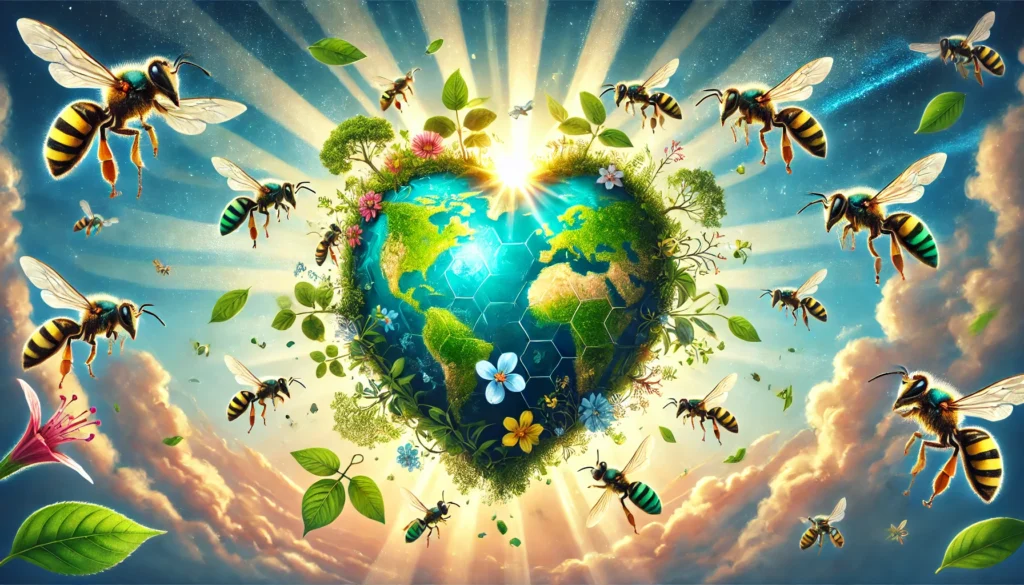
1.Natural Pest Control: As Mentioned above, Paper Wasps are hugely helpful with pest control for growing plants. Studies show that paper wasps capture substantial numbers of garden pests. For instance, a single colony of Polistes versicolor can consume thousands of caterpillars annually—around 4,000—while also acting as pollinators by visiting flowers for nectar.
2. Effective Pollinators: While they may not be as famous as bees, paper wasps are also valuable pollinators. As they forage for nectar to fuel their energy, they brush against flowers and transfer pollen in the process. This accidental pollination supports the growth of fruits, vegetables, and wild plants—making them quiet contributors to garden health and biodiversity. Their dual role as pest controllers and pollinators makes them true ecological allies
3. Food Chain Support: Adult wasps and larvae provide nourishment for birds, lizards, and other predators. Their presence indicates a healthy ecosystem and encourages biodiversity.
4. Scientific Innovation: Recent works show that peptides from Polistes wattii venom can fight multi‑drug resistant bacteria like S. aureus and Salmonella. More broadly, venom-derived compounds are being explored globally to produce antimicrobial drugs in response to increasing antibiotic resistance.
More Fascinating Facts About Paper Wasps
Let’s learn a few more things about these amazing creatures. Paper wasps are far from boring and learning more about them can help us react better to them. Its been scientifically proven that fear and fascination are connected to the same part of the brain. So switching to fascination can help override fear.
Masters of Construction
Paper wasps typically build their nests in areas sheltered from bad weather, like the eaves of buildings, tree branches, or similar over hangs. These nests are incredibly intricate. The paper-making skills of these wasps are truly remarkable.
Paper wasps are skilled architects. They harvest wood fibres from weathered fences, sheds, or plant stems, then chew the material into a paper-like pulp by mixing it with saliva. With this mixture, they construct elegant, umbrella-shaped nests, suspended delicately by a thin stalk called a petiole. Each hexagonal cell in the nest is crafted with precision, housing eggs, larvae, and pupae.
These structures are not only functional but also environmentally efficient, as the wasps recycle natural materials into protective homes. This sustainable building technique have even inspired human engineers!
Their nests quietly coexisting with humans unless disturbed. Watching one being built is like observing a living art installation in motion.
They’re not only ecologically sound but paper wasps are generally less aggressive than their yellow jacket cousins. They’re more focused on building and maintaining their nests than on crashing your picnic.
Intricate Life Cycle of Paper Wasps
The life of a paper wasp colony unfolds with seasonal elegance:
- Spring: A single mated female or a small group of them begins nest construction and lays the first eggs. The strongest female typically becomes the queen, while others may serve as subordinates.
- Early Summer: Eggs hatch within 5–8 days. The larvae are fed chewed-up insects by the queen or early workers. After growing, they spin silk caps over their cells and pupate for 8–18 days before emerging as adults.
- Midsummer: The colony grows rapidly. By July or August, some nests may contain up to 200 individuals, though UK nests tend to be smaller.
- Autumn: As temperatures cool, the queen stops laying eggs. New males and potential queens (gynes) are produced. After mating, these future queens find sheltered places to hibernate. The remaining workers die off, and the nest is abandoned.
This life cycle is a remarkable display of teamwork, timing, and purpose – repeating itself each year with quiet persistence.
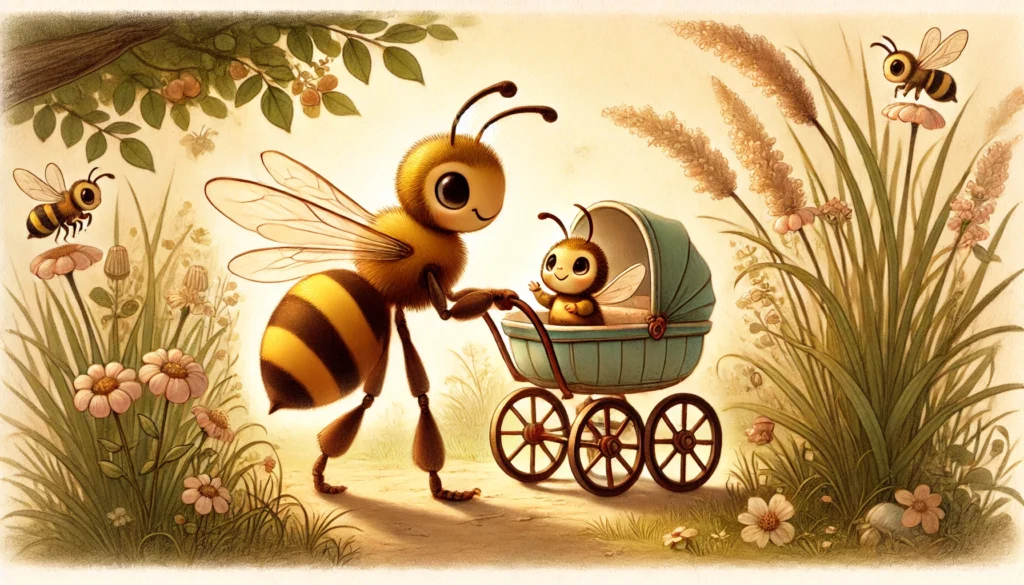
Cooperative Social Life of Paper Wasps
Paper wasps exhibit eusociality, meaning they live in cooperative, socially structured colonies with a division of labour. Although less rigid than honeybee hives, their colonies operate smoothly: queens focus on reproduction, while sterile workers forage for food, care for young, expand the nest, and protect the group.
Conflict within the colony is usually resolved without violence. Social rank can shift over time, and roles adapt based on the needs of the nest—showing a surprisingly flexible and peaceful form of governance.
This cooperative behaviour is not only efficient but deeply admirable. It reminds us that even small creatures thrive through collaboration and shared responsibility.
Chemical Communication and Recognition
Communication is vital to paper wasp societies, and they excel in using chemical cues:
- Cuticular hydrocarbons – wax-like compounds on their exoskeleton – help wasps identify nestmates and regulate hierarchy. Each colony develops its own unique chemical “signature,” ensuring outsiders are easily recognised and kept out.
- Alarm pheromones are released when a nest is threatened. These chemicals signal other wasps to come to the defence of the colony.
- Some species even produce ant-repellent chemicals, which they apply to the stalk of the nest to prevent ants from climbing up and stealing their eggs.
This sophisticated chemical language allows wasps to maintain order, protect their young, and work together effectively -all without a spoken word.
The End of Summer: Paper Wasps Aren’t Aggressive Just Hungry
As summer fades and autumn approaches, paper wasps go through a profound transition. Despite popular belief, late-season wasps aren’t more aggressive – they’re simply at the end of their journey.
By September, the colony is no longer needed, accomplishing its goals. The queen has stops laying eggs, and most new wasps emerging are males and future queens preparing to mate and hibernate. With no young to care for and no nest to defend, the workers are essentially “retired.” They’ve been evicted from their now-disbanding nest, left to wander freely until the cold ends their brief lives.
Therefore, this means at this stage, paper wasps pose little threat. They’re not driven by territorial defence or aggression. Instead, they’re simply looking for one last source of energy – usually sugar. This is why they might hover around your drink, a fallen piece of fruit, or a jam sandwich at a picnic.
Understanding this can shift fear into empathy. These insects, who’ve spent the summer helping our gardens thrive by eating pests, are just trying to enjoy one final sweet moment. Their gentle persistence is not a sign of threat but of natural decline.
Rather than swatting them away, consider calmly placing a piece of overripe fruit in a corner of the garden or park. It’s a small act of coexistence that honours their role in the ecosystem and makes the outdoors more peaceful for everyone.
Choosing Kindness: How We Can Live Peacefully with Paper Wasps
When we fear paper wasps, we miss a chance to peacefully coexist with a creature that simply wants to be left alone. Wasps don’t seek conflict—they protect their young, just as any living being would. Their goal isn’t to attack but to survive and care for their offspring.
Paper wasps aren’t interested in humans. They don’t chase us or act aggressively without reason. Their days are spent building nests, feeding larvae, and fading quietly with the seasons. When we understand that their sting is only a defence of their home, fear begins to fade.
With a few simple changes, we can share space with them more easily:
- Stay calm: Quick movement seems threatening. Slow, steady motions help avoid provoking them.
- If you feel scared: Breathe deeply. Focus on your strength and the wasp’s peaceful intentions. Relax your body and even try smiling to send calming signals to your brain.
- Avoid disturbing nests: If you find one, give it space. Most will become inactive by autumn.
- Offer distractions: A small plate of ripe fruit placed away from your meal can lure them elsewhere.
- Limit sweet scents: Perfumes, sugary drinks, and floral prints can attract wasps by accident.
These small acts of understanding aren’t just about avoiding stings – they’re about choosing respect. When we respond with compassion instead of fear, we’re also setting a powerful example for children and others around us.
Coexisting with paper wasps can even be rewarding. Observing their elegant nest construction, cooperative teamwork, and curious behaviour can foster a surprising sense of connection to the natural world.
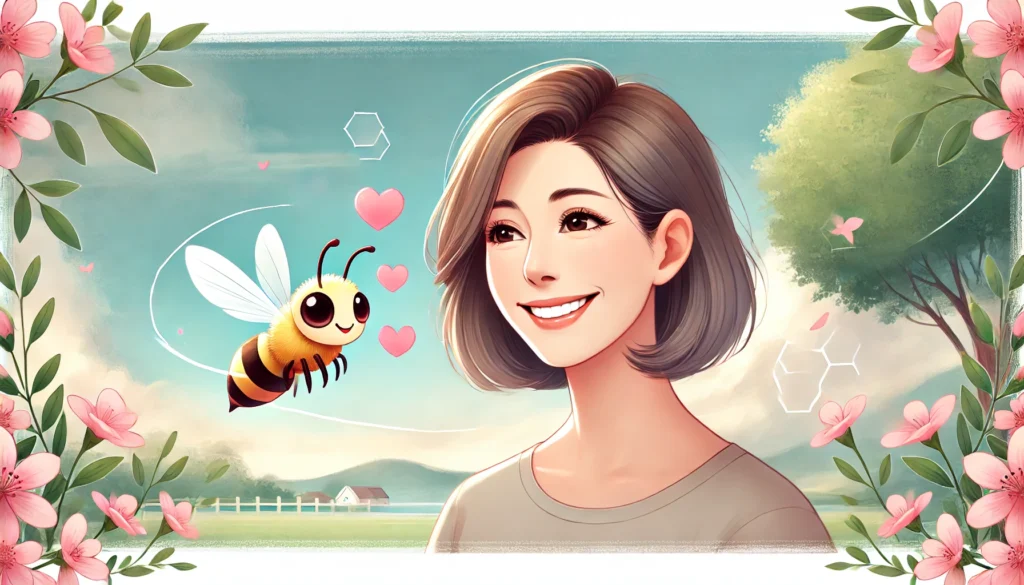
Overcome Your Fear of Paper Wasps with Creature Courage
Overcoming a fear of wasps begins with understanding, not avoidance. The first step is recognising that your fear is learned and, more importantly, can be unlearned. Modern therapeutic approaches such as Cognitive Behavioural Therapy (CBT), exposure therapy, and NLP (Neuro-Linguistic Programming) gently retrain the brain to respond calmly, rather than fearfully, to wasps.
At Creature Courage, we specialise in a holistic approach that combines these proven methods with mindfulness, emotional resilience training, and guided exposure to build confidence quickly. Most people are amazed at how much lighter and freer they feel after just one focused session. Instead of reacting with panic, you’ll gain the tools to stay calm, curious, and in control—unlocking not just relief from the phobia, but a new, empowering relationship with nature.
Overcome Your Fear of Wasps in Just One Day
If your fear of paper wasps is preventing you from enjoying your outdoor spaces, it’s time to take control of your fears. Don’t let fear of these fascinating architects keep you indoors – contact Creature Courage today and start building a new relationship with paper wasps!
FAQ: Beating Spheksophobia & Understanding Paper Wasps
What’s the difference between fear and phobia of paper wasps?
Fear is rational and manageable; spheksophobia causes overwhelming panic even at a nest’s sight
How quickly does Creature Courage therapy work?
Most UK clients become phobia-free in just one day-long programme .
Are paper wasp stings dangerous?
Only about 1% in the UK risk a severe allergic reaction. For most, a sting is painful but not life-threatening
Can living near wasps be safe?
Yes. By adopting polite coexistence—such as keeping calm, avoiding nests, and using natural repellents—wasps rarely sting.
Which therapy method is most effective for a wasp Phobia?
Exposure-based CBT is widely recommended, but Creature Courage’s unique blend offers rapid, lasting change
What’s the benefit of a holistic approach for a wasp phobia?
Beyond overcoming the phobia, you learn coping skills that help with general anxiety and everyday stress.
